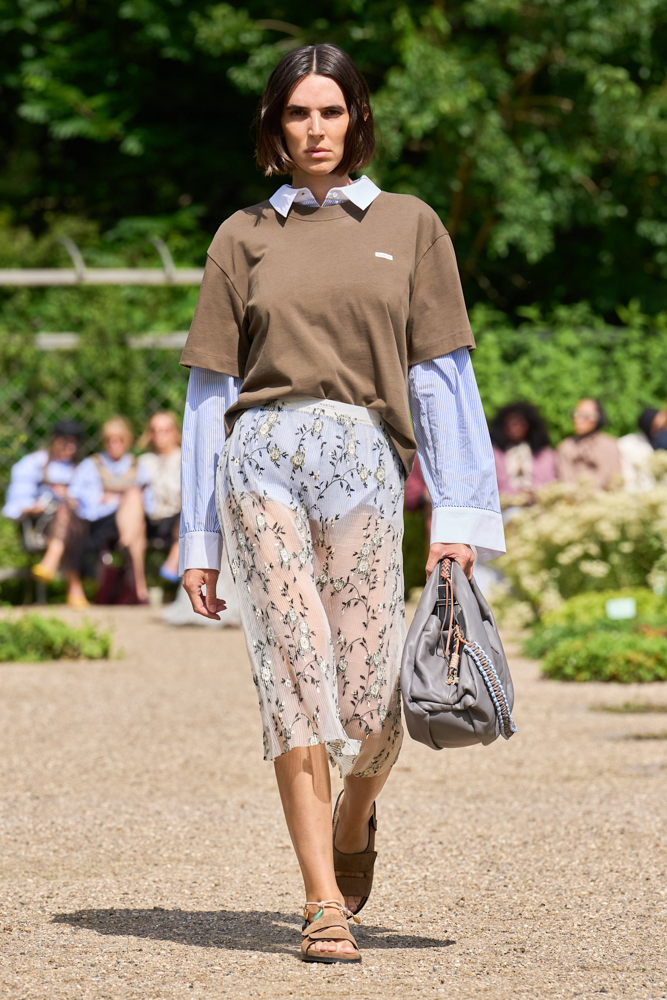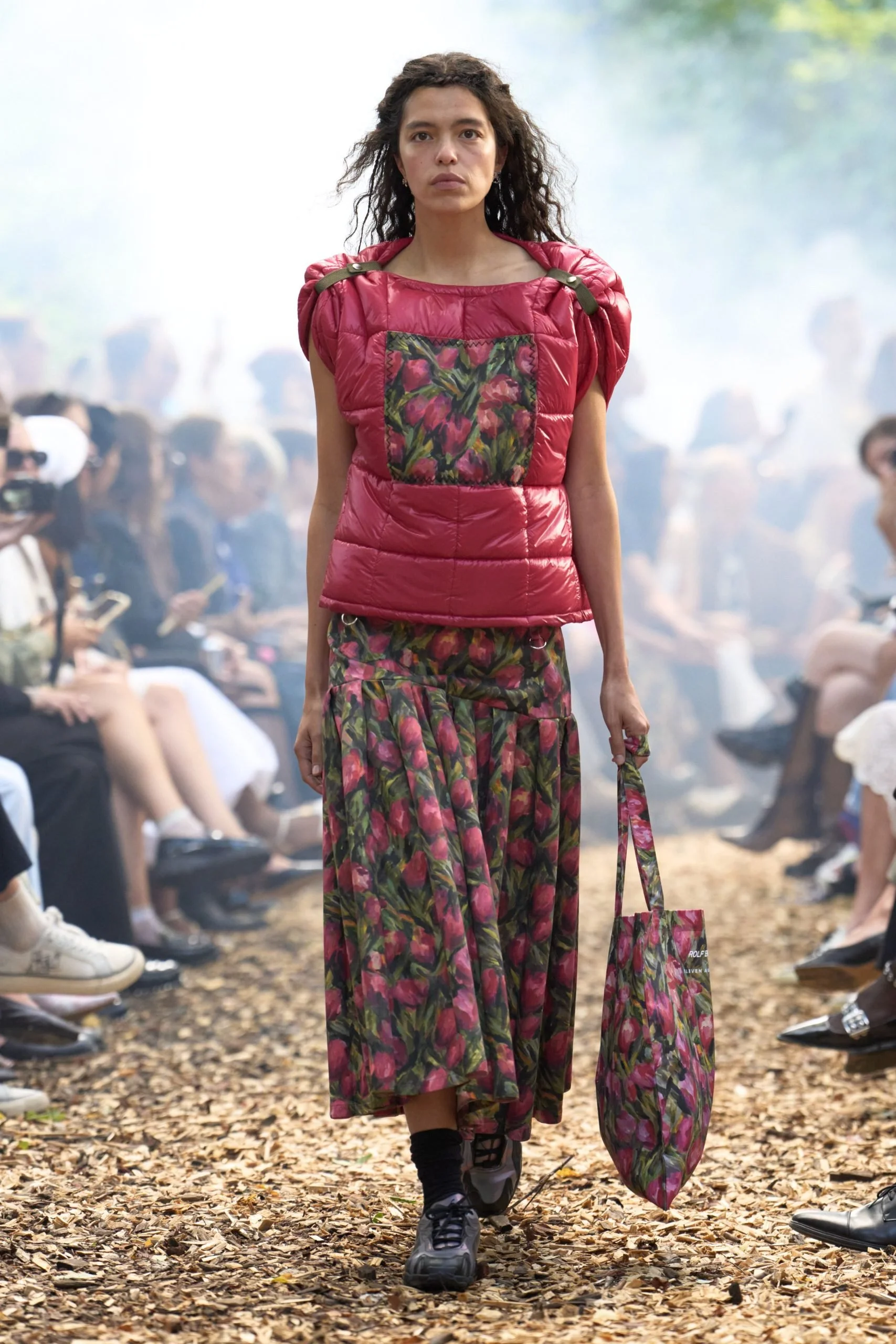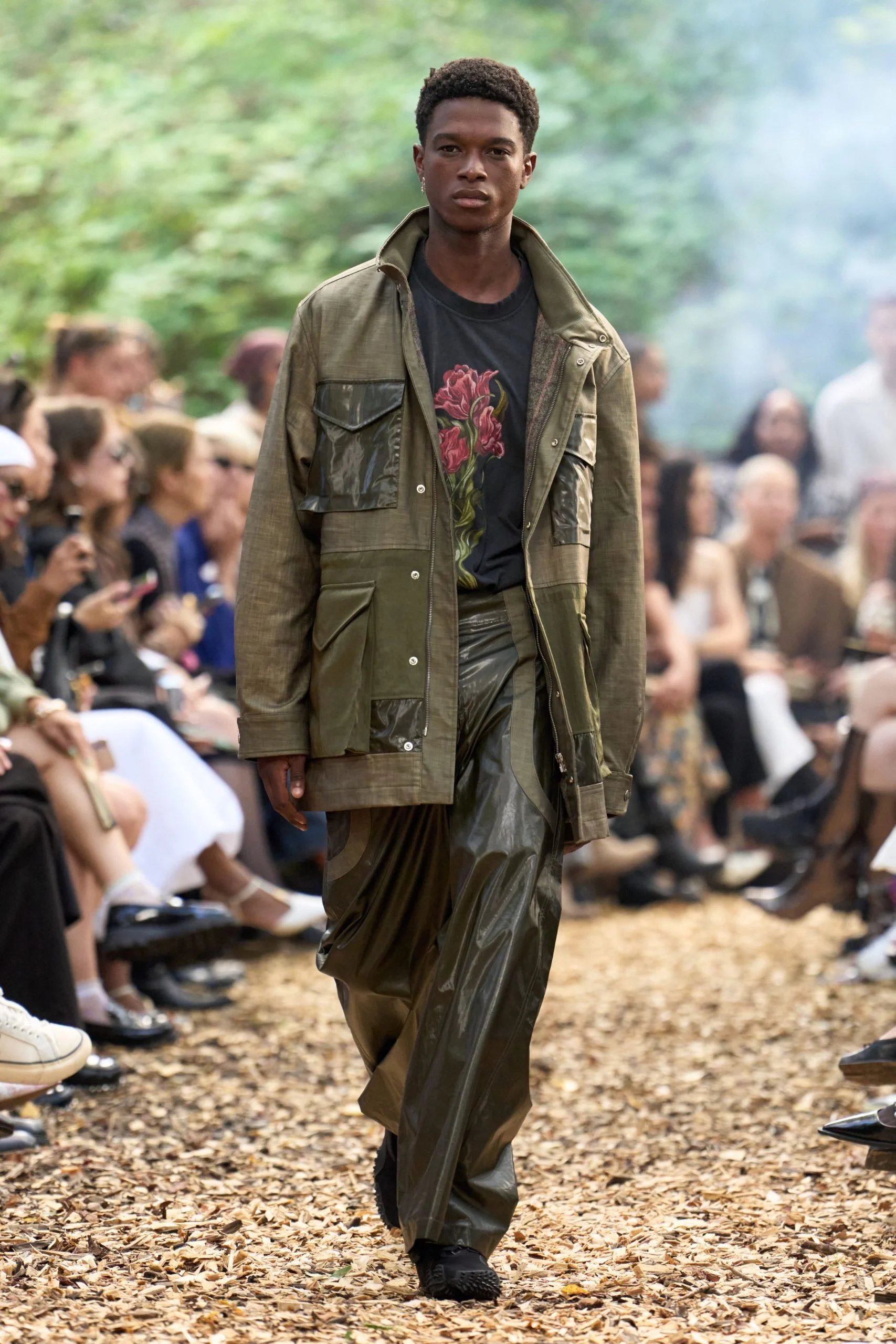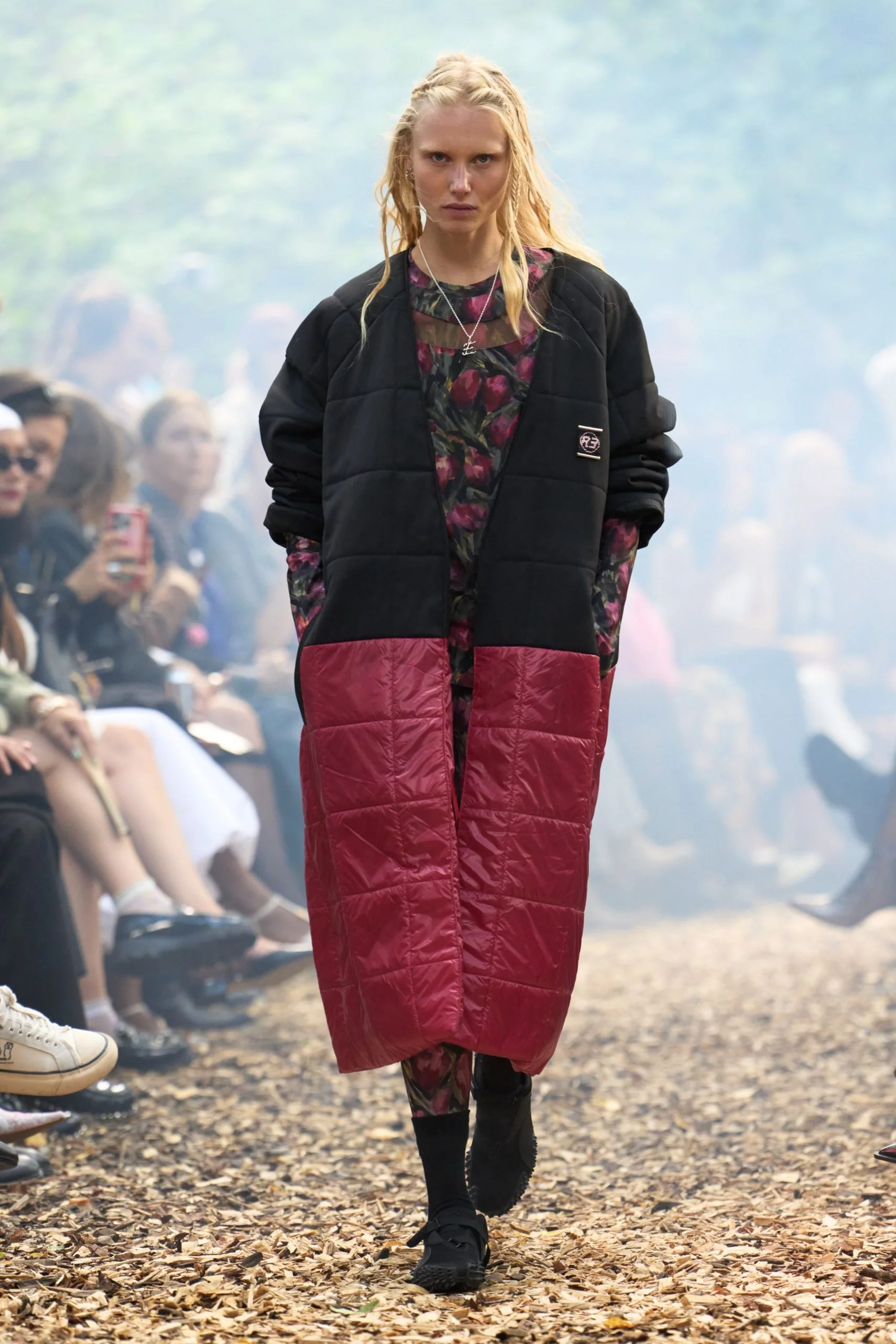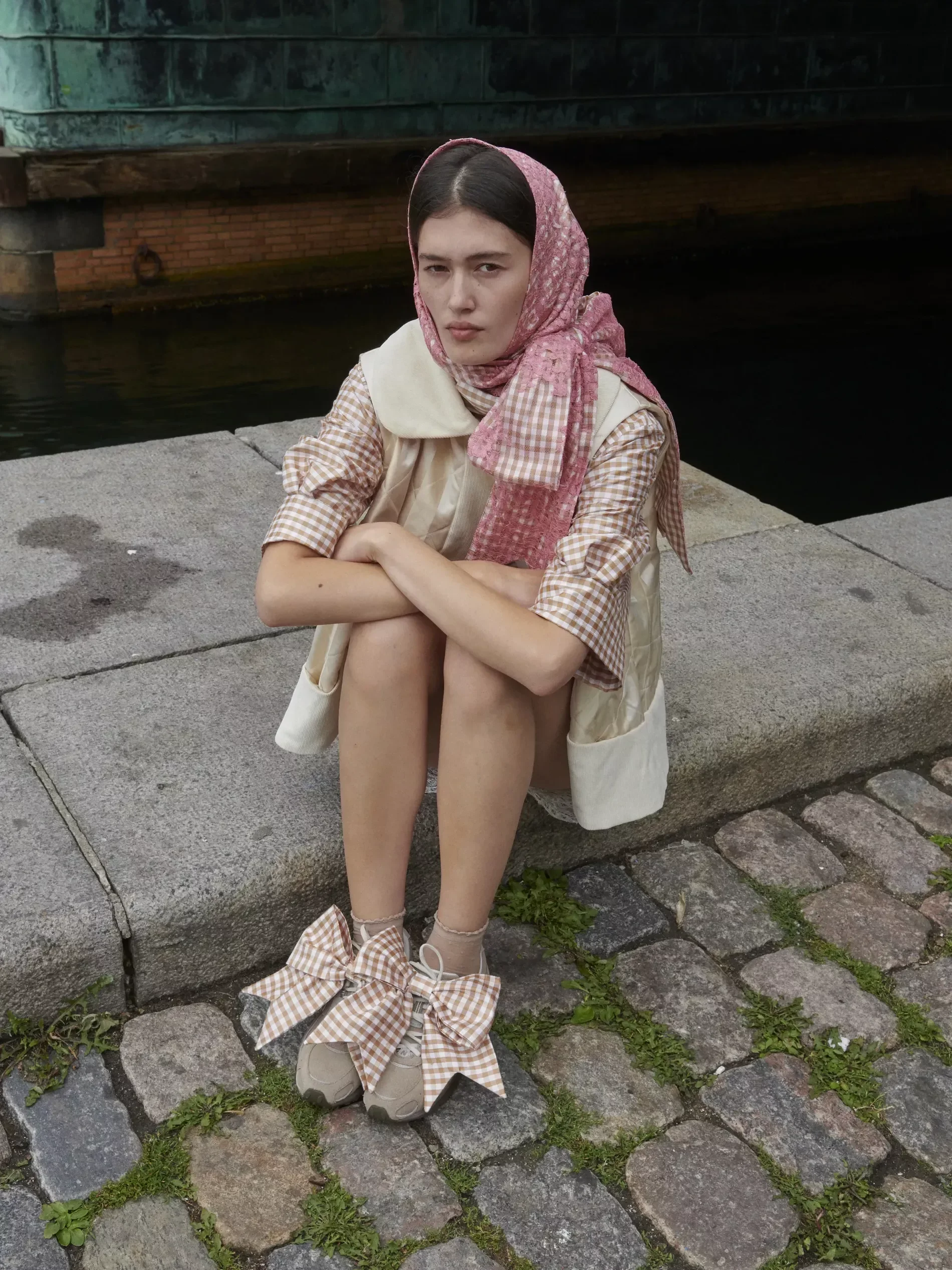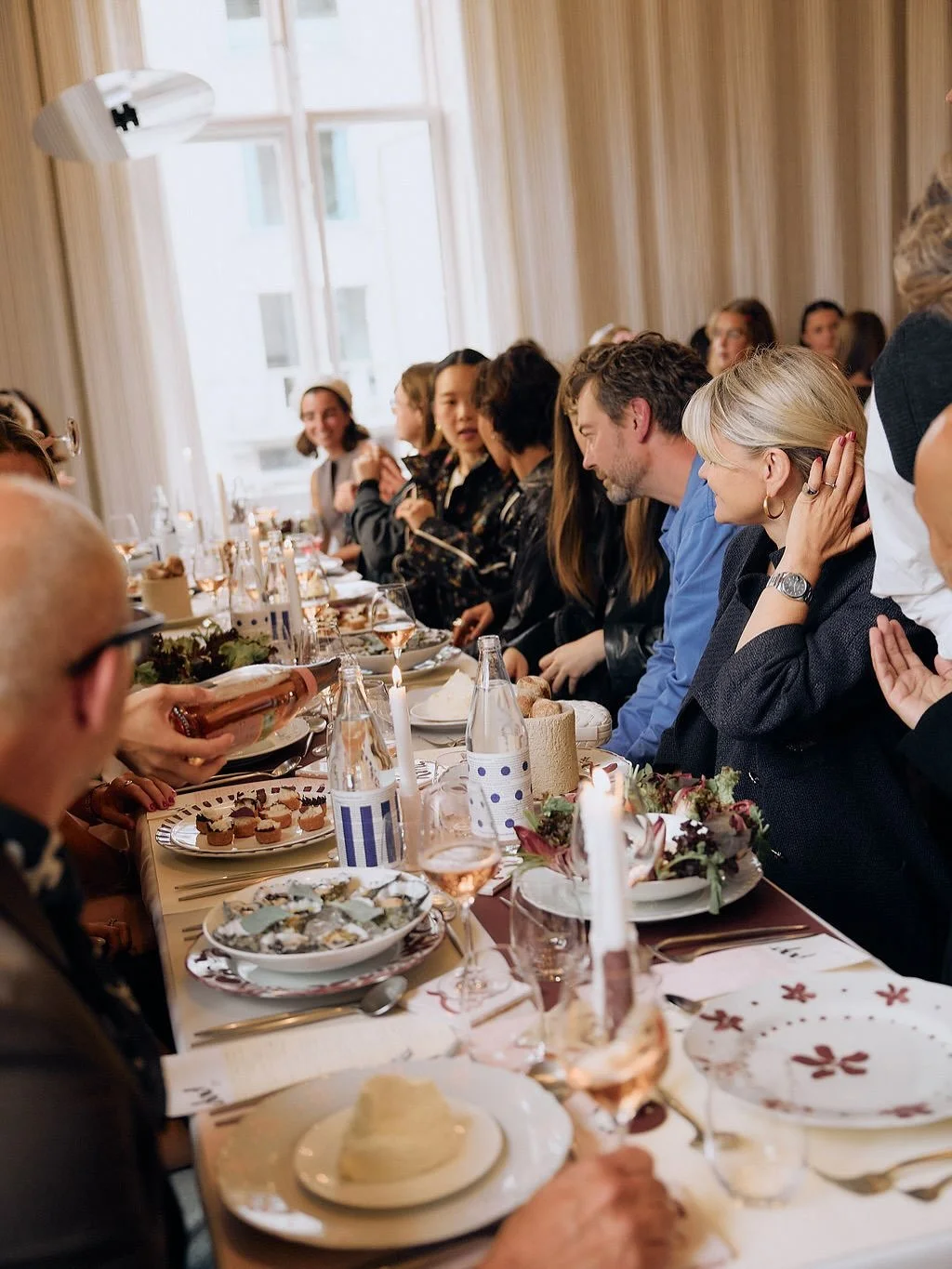Copenhagen Fashion Week SS26 Florals: When Fashion and Floristry Converge
Copenhagen Fashion Week Spring/Summer 2026 (SS26) was nothing short of a floral extravaganza, a season where runways and venues alike blossomed with botanical creativity. Taking place August 4-8, the week highlighted how deeply fashion and floral design are intertwined in contemporary couture. From petal-strewn prints and textured floral runway trends to garden-inspired set pieces and even edible flowers at brand dinners, SS26 in Copenhagen proved that floristry’s influence in fashion is more vibrant than ever. This report, from a florist’s perspective, examines the key floral motifs and botanical references that defined the collections, the scenography of shows and events, and how flowers translated emotionally, architecturally, and even gastronomically into the week’s experiences.
Florals Bloom on the SS26 Runways
A model on OpéraSport’s Spring 2026 runway wearing a white ribbed knit top and skirt adorned with 3D floral lace appliqués, exemplifying Copenhagen Fashion Week’s textured floral trend.
Designers in Copenhagen used floral motifs as a springboard for both creativity and craft on the runway. Not content with simple prints, many took florals into three dimensions.
Think appliquéd petals, sequin blooms, and laser-cut lace flowers adding depth to garments. Collections from labels like OpéraSport, Munthe, and Cecilie Bahnsen exemplified this 3D approach, “crafting florals that are three-dimensional and full of life”. Instead of flat botanical prints, these brands layered materials to create tactile blooms.
For instance, OpéraSport showed ribbed knit dresses embellished with scattered lace flower appliqués, giving classic white ensembles a fresh, blossoming texture.
Cecilie Bahnsen, known for her ethereal, romantic aesthetic, returned to Copenhagen with an anniversary collection of voluminous white dresses punctuated by signature laser-cut florals on organza and tulle. The effect was as if each piece were a living bouquet, with fabric petals fluttering around the models as they moved.
Designers across CPHFW SS26 reimagined florals with such sculptural, textured treatments, a direction Vogue’s trend tracker dubbed “nu florals,” noting it marked a departure from conventional prints toward more inventive blooms. This floral runway trend marries femininity with innovation, perfect for those looking to add a fresh twist to classic spring florals.
Not every designer went the 3D route.
Some embraced traditional botanical prints but gave them a modern context. A few collections channeled cottagecore nostalgia by using Liberty-style floral prints and headscarves, bringing a homespun romance to their spring looks. This stood in charming contrast to the darker trends (such as the “summer goth” leather moments elsewhere), proving the enduring versatility of florals.
Colors, too, took cues from blossoms: a quietly audacious palette of soft blues, plums and pinks swept through many collections, infusing runways with the hues of a summer garden at dusk. In fact, designers were so smitten with florals that some even built entire lines around them.
Swedish label Rave Review presented a standout collection titled “Blommornas Makt”, Swedish for “Power of Flowers”, which treated the flower not as a cliché motif but as a potent symbol and design philosophy.
A model on the Munthe SS26 runway layers a sheer organza skirt embroidered with delicate flowers over casual shirting, blending airy florals with Scandinavian ease.
“The theme that grounds the collection is the flower, not as a retro motif, but as a powerful symbol with deep historical weight,” explained Rave Review’s Josephine Bergqvist.
True to that vision, Rave Review’s pieces were literally constructed from floral materials: the designers upcycled vintage flower-print home textiles and deadstock fabric, heat-pressing floral bed linens into sculptural suiting (for example, turning a chintzy rose-print bedsheet into a sharp-shouldered pink blazer and pencil skirt).
They even drew structural inspiration from real-world floral celebrations, citing Dutch tulip festival costumes as a reference for their puffed sleeves and apron-like layered skirts. The result was a genre-defying ode to blossoms that felt at once romantic and rebellious, merging flower-child nostalgia with punkish upcycling.
In short, Copenhagen Fashion Week SS26 florals ran the gamut from delicate embroidered buds to avant-garde flower power statements, each designer finding new ways to make botanicals bloom in fashion.
This breadth of interpretation highlights how fashion and floristry intersect on multiple levels. Whether through laser-cut floral patterns on airy gowns or homespun calico prints on skirts, flowers provided an emotional and material vocabulary for designers to express renewal, optimism, and even resistance.
As Saks Fifth Avenue’s fashion director observed, one of the defining themes of the week was “Danish summer” charm, “easy poplin, lace and crochet, florals, and layered knits” giving collections a breezy, optimistic appeal. Indeed, florals were central to that vibe, embodying the lightness and joy of Scandinavian spring style.
Even street style outside the shows nodded to blooms, with guests donning floral embroidery and blooming prints in their outfits, turning Copenhagen’s cobbled streets into a veritable catwalk of flower-inspired looks.
Botanical Scenography and Set Design
Floral influences were not limited to clothing, they extended into the scenography and set designs of the shows themselves.
In Copenhagen, designers understand that the atmosphere of a presentation can amplify the story a collection tells, much like how a well-crafted floral installation can transform a space. This season saw several brands use nature and botanicals as backdrops, creating immersive environments that complemented their clothes.
One of the most talked-about venues was selected by The Garment, which staged its show in the Royal Stables at Christiansborg Palace, an 18th-century horse stable that had never before hosted a fashion show.The choice of this grand, historic setting (complete with the scent of hay and the presence of centuries old white carriage horses in adjacent stalls) imbued the collection with every horse girl’s wildest dreams.
While not a literal flower garden, the venue’s old-world grandeur and natural elements felt organic and storied, as if models were walking through a living tableau of Danish heritage. The stables’ arches and straw-lined floors provided an earthy, textural stage that a florist might liken to the raw greens and branches in a wild centerpiece, an unexpected yet enchanting frame for contemporary fashion.
Elsewhere, designers actually brought their shows into nature. Finnish designer Rolf Ekroth sent models down a woodland path during golden hour, using a forest clearing as his. Guests sat among trees and late-summer wildflowers as the sun began to set, an atmosphere no set decorator could rival. The woodland scenography cast a spell of natural beauty, making it feel as though the designs were emerging from the landscape itself. This blur between runway and nature heightened the botanical theme, fabrics and foliage in dialogue under the Copenhagen sky.
Model at Rolf Ekroth Copenhagen Fashion Week SS26 runway wearing a red quilted vest layered over a tulip-print dress with matching tote, a bold floral motif blending sport and romance.
Male model at Rolf Ekroth Copenhagen Fashion Week SS26 in olive utility jacket and wide-leg pants styled with a tulip-print T-shirt, military silhouettes softened by floral graphics.
Rolf Ekroth look from Copenhagen Fashion Week SS26 featuring a black and red quilted coat over a tulip-patterned dress, sculptural outerwear framing floral prints.
Similarly, other brands opted for striking outdoor locations: one show took place poolside at a public aquatic center, and another atop a concrete water tower for an urban-meets-nature contrast. Even when venues were industrial or unexpected, many shows incorporated organic touches. Danish label Caro Editions famously recreated its founders’ wedding for their SS26 presentation. The show was set canal-side at the very venue where the designers were married, complete with the intimacy and joy of a real wedding (sparkling wine handed to guests, wedding bells tolling ) and we can imagine floral arrangements similar to a bridal setting lining the scene.
Model in Rave Review’s Blommornas Makt collection at Copenhagen Fashion Week SS26, wearing a gingham dress with oversized bow sneakers and a pink headscarf, a playful reinterpretation of floral power through textile upcycling.
By invoking a wedding’s visuals and emotions, Caro Editions effectively wove floristry-adjacent elements (like celebratory blossoms and romantic symbolism) into their fashion narrative.
At Rave Review’s “Blommornas Makt” show, the setting itself became part of the floral storytelling. They chose the historic Nikolaj Kunsthal, a deconsecrated church with soaring ceilings and stained-glass windows, as the venue.
While the space wasn’t filled with flowers per se, the ambiance was ethereal and reverential, akin to entering a sanctuary of flora. Live vocals by an experimental artist echoed through the hall, creating an atmosphere of calm beauty “between calm beauty and asymmetric obscurity” that mirrored a blooming garden at twilight.
In a way, light and sound became the flowers of this scenography: stained glass threw watercolor-like patterns (reminiscent of petals filtering sunlight) onto the runway, and the music’s organic, haunting tones gave life to the concept of flowers as symbols of heritage and persistence.
This thoughtful use of venue and mood illustrates how botanical references can be conveyed beyond literal plants – through architecture, light, and narrative. Much like an artful floral arrangement, the show environments were composed with balance and intention.
The set design and locations across CPHFW SS26 consistently reinforced a connection to nature, seasonality, and renewal, underscoring each collection’s themes with an experiential layer.
As a florist, it was fascinating to see fashion shows employ principles we use in event floristry: choosing a locale with character, playing with natural light, and integrating elements like wood, water, or greenery to create a specific emotional response.
In Copenhagen, the runway wasn’t just a platform for clothes – it was a garden bed in which the week’s creative visions could fully flourish.
Floral Hospitality: When Fashion Serves Blooms
Perhaps the most innovative fusion of floristry and fashion happened off the runway, in the realm of hospitality. Copenhagen Fashion Week SS26 blurred the line between fashion show and experiential event, as many brands eschewed traditional catwalks in favor of intimate dinners, breakfasts, and parties that extended their design narrative into food, decor, and ambiance. This approach can be thought of as floral hospitality in fashion, where labels engage the senses (taste, smell, sight) much like a holistic event designer or florist would, using culinary and botanical elements to enrich the experience of their collection.
Stine Goya’s Guest House dinner, Copenhagen Fashion Week SS26 scene, guests gathered at a long table set with patterned plates, natural light, and seasonal dishes.
Vogue Business described this trend as “sensory marketing, using food and beverage”, noting a surge in branded meals and pop-ups designed to entice and immerse show-goers. The official schedule featured 12 breakfasts, 2 cocktails, and 6 dinners during the week, and each gathering became an opportunity for creative expression.
Stine Goya, for example, opted not to stage a runway show for SS26 and instead hosted an exclusive dinner titled “The Guest House” on Tuesday evening. In collaboration with Copenhagen culinary studio File Under Pop and Michelin-starred chef Morten Falk, Stine Goya crafted a dining experience that was as artful as a still-life.
Guests arrived at File Under Pop’s studio, a space already rich with artistic surfaces and color, to find hand-painted plates and personalized, painted coasters at each setting. Painted fabric drapes lined the archways of the room, almost like a modern art take on floral garlands, infusing the venue with strokes of color and pattern.
The tablescape itself was an Instagram-ready tablescape masterclass: abundant bowls of ripe cherries, mountains of whipped butter sculpted almost like peonies in bloom, and artistic platters that blurred the line between food and décor.
As for the menu, it literally served flowers, one of the evening’s delights was stuffed courgette blossoms, tying directly into the botanical theme on the plate. Delicate zucchini flowers were filled with savory stuffing, a dish that not only pleased the palate but also echoed the collection’s ethos of quiet beauty and welcome. Plates of candied fruit followed, each glistening slice resembling a candied petal or piece of edible potpourri.
Hand-painted floral plates and calligraphed place cards at Stine Goya’s Guest House dinner, Copenhagen Fashion Week SS26 - blending design, dining, and botanical motifs.
From a florist’s perspective, this dinner was a revelation: it translated the emotional palette of Stine Goya’s fashion (memory, mystery, and the “quiet beauty of being welcomed in”) into a multi-sensory feast, where edible flowers and artful presentation set the mood just as much as any bouquet could.
The floral influence in food presentation continued at other events.
On Wednesday morning, cult homeware and apparel brand Tekla hosted a breakfast that doubled as a preview of its new collection of pillows, robes, and shirting. This gathering embraced a cozy, domestic vibe – appropriate for a label known for quality textiles, and it incorporated seasonal produce as naturally as a country kitchen. Long farm tables were laden with platters of deep-purple plums, flaky Danish pastries, and neatly sliced cheeses on buttered buns, each arranged in perfect straight lines.
The precision of the layout (those uniformly spaced rows of treats) felt akin to floral patterning, almost like viewing a carefully planted orchard from above. The effect was both visually satisfying and fragrant, with the sweet aroma of plums and baked goods wafting through the air. In lieu of centerpiece bouquets, the food itself became the décor, celebrating the late summer harvest.
Tekla’s breakfast demonstrated a subtle floral hospitality ethos: without a single flower on the table, it still evoked the comfort and abundance of a Scandinavian garden in summer, aligning with the brand’s emphasis on natural materials and well-crafted comfort.
Even traditional fashion presentations incorporated edible floral touches. During By Malene Birger’s SS26 dinner, held inside the brand’s Copenhagen flagship store, guests enjoyed an Italian-inspired feast prepared by chef Marion Ringborg, where one could imagine herb garnishes and floral notes complementing the dishes. (This dinner was elevated by a special live performance from singer Coco O., adding an arts-and-culture flourish to the night.)
Table setting at Malene Birger’s dinner at Copenhagen Fashion Week SS26. Linen tablecloths, tapered candles, and wildflower-inspired arrangements.
Guests at Malene Birger’s Copenhagen Fashion Week SS26 dinner holding a fashion magazine at the table, merging editorial imagery with intimate dining.
Overhead view of Malene Birger’s Copenhagen Fashion Week SS26 dinner, long table with neutral linens, candles, and botanical centerpieces.
And in a playful twist, The Garment hosted a highly talked-about pink-themed dinner. This event leaned into whimsy and color: the table was a study in pink, and for the occasion the brand presented a food display made up of pink cotton candy and fresh pink peas. Picture tufts of rosy cotton candy rising out of serving dishes like giant blooming carnations, paired with bowls of blush-tinted peas, a surreal garden on the dinner table.
The monochromatic pink spread nodded to one of the season’s standout hues (designers across Copenhagen were, indeed, “tickled pink” with head-to-toe rose ensembles on the runways) and created a dining atmosphere that was fun, nostalgic, and a bit magical. It’s a clever example of using color and form, key tools in floristry, to design a memorable setting. Just as an arrangement of pink peonies can convey playful romance, The Garment’s cotton candy centerpiece brought an element of childlike delight, inviting guests to experience the collection’s spirit through taste and sight.
Collectively, these food-focused events illustrate how fashion brands are embracing florals beyond the fabric, extending into the realm of hospitality and lifestyle. By engaging chefs, interior designers, and florists, Copenhagen’s labels created cohesive worlds around their collections. The emotional resonance of flowers, their ability to comfort, to excite, to evoke seasons past, was leveraged at the dining table as much as on the catwalk.
Whether it was through an edible blossom on a gourmet plate or a color-coordinated culinary installation, florals provided a through-line that connected what people were wearing to what they were tasting and seeing around them. This immersive strategy not only reinforces a collection’s theme but also leaves a lasting impression on attendees (and flooding social media feeds with gorgeous, on-brand imagery). It’s a holistic approach to storytelling that any event florist can appreciate: every element, from centerpieces to canapés, works in harmony to celebrate the seasonal and sensory beauty of flowers.
The Emotional & Architectural Language of Flowers in Fashion
The Garment’s all-pink dinner was essentially a monochromatic floral arrangement made edible, using color blocking and repetition (a technique florists use when massing blooms of one color for impact) to achieve drama and cohesion.
Ultimately, Copenhagen Fashion Week SS26 demonstrated that when it comes to creative expression, fashion and floristry speak the same language. Designers and florists are both storytellers who use visual compositions to evoke feeling. This season’s floral runway trends and botanical experiences showed an acute understanding of that fact. Flowers were not just decoration; they were central characters in the narrative, woven into fabrics, printed onto boots, draped over doorways, garnishing cocktails, and inspiring palettes.
In Copenhagen, a runway look with floral appliqué could resonate in the memory much like a striking floral arrangement: both are alive with detail, both engage the senses, and both can transform an environment. As the fashion industry leans into experiences and emotional connection, it’s likely we’ll continue to see this blooming partnership of floristry and fashion design.
After all, both are about celebrating beauty and life’s seasons, and in Spring/Summer 2026, Copenhagen proved that when fashion serves blooms in every sense, the result is a truly organic and unforgettable style statement.
Why do flowers prove to be such a powerful inspiration across creative fields? From the perspective of a floral expert observing Copenhagen Fashion Week SS26, the answer lies in the rich emotional and architectural language that flowers offer to fashion. Floristry and couture share core principles: both play with color palettes, texture layering, structural form, and symbolism to elicit feelings. This season in Copenhagen underscored that synergy in unprecedented ways.
Emotionally, flowers carry a weight of meanings – romance, hope, renewal, nostalgia, even protest – and designers tapped into all of these. The very theme of CPHFW SS26 was “Renewal”, a fitting motif for springtime collections. Florals naturally embody renewal (think of spring blossoms after a long winter), so
In the realm of experience design, flowers also guided how brands constructed their events and visuals. A florist curating an event aims to create an immersive atmosphere; so did Copenhagen’s designers and creative directors. We can draw parallels: arranging a runway or dinner venue is like arranging a large-scale floral installation. One must consider focal points, harmony, seasonality, and mood. The painted drapes and fruit displays at Stine Goya’s dinner functioned much like a grand floral centerpiece – drawing the eye and setting the tone in one stroke.
With love, Sarah
Founder of KKOTJÄM, a floral design studio rooted in emotion and sensory storytelling. Last seen in New York City.




